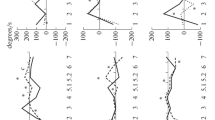Summary
The modifications occurring in the movement and muscle activity patterns of the leg when changing from forward to backward walking were studied in five healthy subjects during walking on a motor driven treadmill. Movements were recorded with a Selspot optoelectronic system and muscle activity with electromyography using surface electrodes. The movement trajectories of the leg in forward and backward walking essentially mirrored each other, even though the movements occurred in the reversed direction. The angular displacements at the hip, knee and ankle joints showed similar overall magnitude and pattern in the two situations. Most of the investigated muscles changed their pattern of activity in relation to the different movement phases. At the ankle, there was a switch between flexors and extensors with flexor activation during support in backward walking. The bursts of activity in knee extensors were prolonged and shifted to the main part of the support phase. In the hip extensors, the activity periods retained their positions relative to the leg movements, but changed function due to the reversed direction of movement. Thus, drastic changes occur in the normal locomotor program to produce a reversal of leg movements and propulsion backwards.
Similar content being viewed by others
References
Cavagna GA (1977) Storage and utilization of elastic energy in skeletal muscle. Exerc Sport Sci Rev 5: 89–129
Forssberg H (1985) Ontogeny of human locomotor control. I. Infant stepping, supported locomotion and transition to independent locomotion. Exp Brain Res 57: 480–493
Grillner S (1981) Control of locomotion in bipeds, tetrapods and fish. In: Brooks V (ed) Handbook of physiology — the nervous system II. Waverly Press, Baltimore, pp 1179–1236
Grillner S (1985) Neurobiological bases of rhythmic motor acts in vertebrates. Science 228: 143–149
Halbertsma JM (1983) The stride cycle of the cat: the modelling of locomotion by computerized analysis of automatic recordings. Acta Physiol Scand (Suppl) 521
Halbertsma JM, deBoer RR (1981) On the processing of electromyograms for computer analysis. J Biomech 14: 431–435
Inman VT, Ralston HJ, Todd F (1981) Human walking. Williams & Wilkins, Baltimore
Miller S, Mitchelson D, Scott PD (1978) Coupling of hip and knee movement during forwards and backwards stepping in man. J Physiol (Lond) 277: 45P-46P
Nilsson J, Thorstensson A, Halbertsma J (1985a) Changes in leg movements and muscle activity with speed of locomotion and mode of progression in humans. Acta Physiol Scand 123: 457–475
Nilsson J, Stokes VP, Thorstensson A (1985b) A new method to measure foot contact. J Biomech 18: 625–627
Patla AE (1984) Some properties of the human locomotor program. Soc Neurosci Abstr 10: 360
Stein PSG (1983) The vertebrate scratch reflex. In: Roberts A, Roberts BL (eds) Neural origin of rhythmic movements. Cambridge University Press, Cambridge, pp 383–403
Stein PSG, Mortin LI, Robertson GA (1986) The forms of a task and their blends. In: Grillner S, Stein PSG, Forssberg H, Stuart DG, Herman RM, Wallen P (eds) Neurobiology of vertebrate locomotion. McMillan Press, Hampshire, England (in press)
Author information
Authors and Affiliations
Rights and permissions
About this article
Cite this article
Thorstensson, A. How is the normal locomotor program modified to produce backward walking?. Exp Brain Res 61, 664–668 (1986). https://doi.org/10.1007/BF00237595
Received:
Accepted:
Issue Date:
DOI: https://doi.org/10.1007/BF00237595



